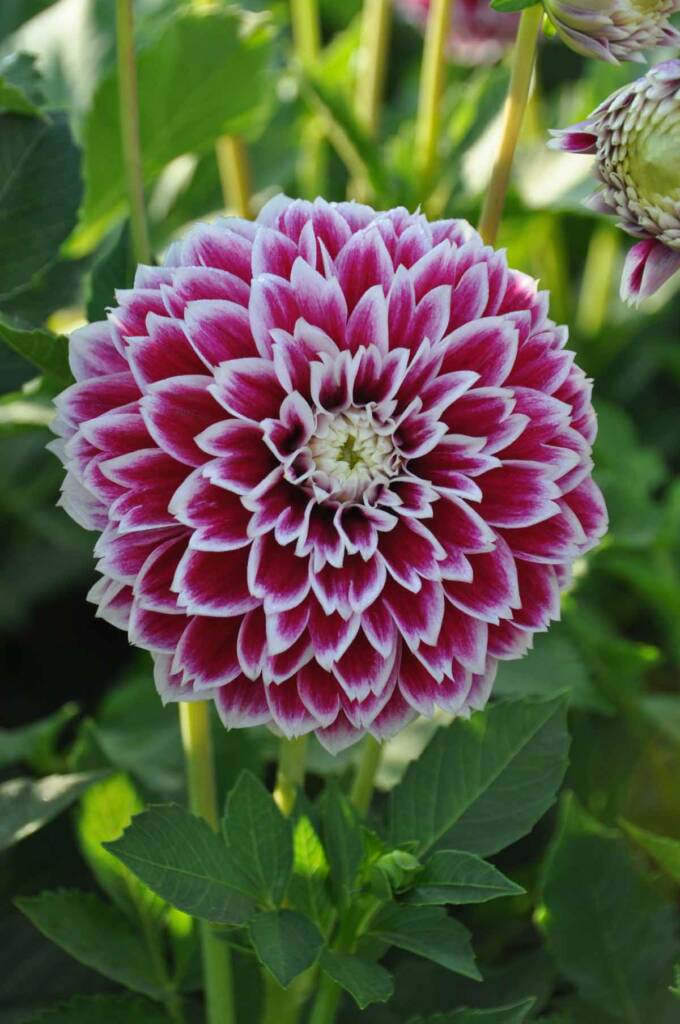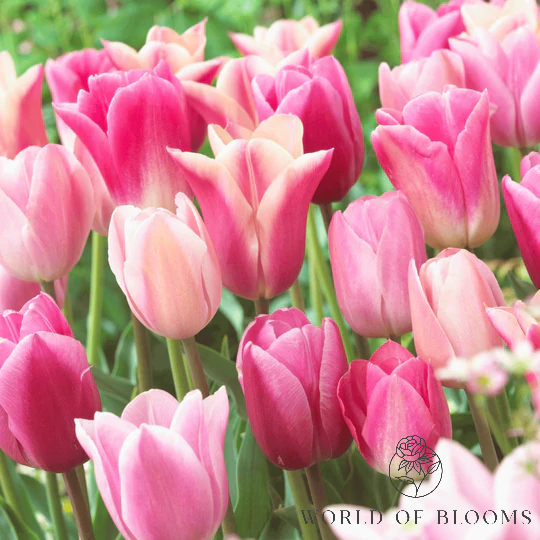Dahlia Decorative 'Jowey Paradise'
Couldn't load pickup availability
Dahlia Decorative ‘Jowey Paradise’ is a breathtaking dahlia variety that exudes grace, charm, and an ethereal beauty. With its soft yet striking coloration, perfect symmetry, and luxurious blooms, it is a must-have for any garden, floral arrangement, or cutting garden. This Belgian-bred dahlia, part of the renowned Jowey series, is prized for its reliability, uniform bloom structure, and exquisite pastel tones. Whether showcased in flower beds, containers, or bouquets, ‘Jowey Paradise’ creates an atmosphere of tranquility and refined elegance.
Zones: 3 - 11
General Characteristics:
- Type: Decorative Dahlia
- Flower Shape: The flowers of the 'Jowey Paradise' dahlia are large and symmetrical, with an overall rounded and slightly flattened appearance. The petals are tightly packed and arranged in a spiral pattern that creates a full and dense look.
- Bloom Color: The 'Jowey Paradise' variety is known for its striking fuschia and pink tones.
- Flower Size: The blooms are large, typically reaching between 6 to 8 inches (15 to 20 cm) in diameter, which makes them very eye-catching both in gardens and as cut flowers.
- Petal Texture: The petals of 'Jowey Paradise' are smooth with a slightly waxy texture. They are thick and sturdy, holding their shape well even in the face of strong winds or rain.
Plant Characteristics:
- Height: The plant grows to a moderate height, generally reaching about 3 to 4 feet (90 to 120 cm) tall. This makes it suitable for both garden beds and containers.
- Spread: The spread of 'Jowey Paradise' is moderate, with the plant reaching a width of about 18 to 24 inches (45 to 60 cm), giving it a bushy, full appearance.
- Foliage: The foliage of 'Jowey Paradise' is deep green, with large, pointed leaves that complement the bright blooms. The leaves have a rich, dark color, providing a strong contrast to the vibrant flowers.
- Growth Habit: This dahlia variety has an upright, bushy growth habit, and like many dahlias, it may need some support or staking, particularly as the blooms become large and heavy.
Growing Conditions:
- Sunlight: 'Jowey Paradise' thrives in full sun, ideally receiving at least 6 hours of direct sunlight each day. This is essential for maximizing flower production and ensuring healthy growth.
- Soil: The plant prefers well-draining soil that is rich in organic matter. Slightly acidic soil (pH 6.0 to 6.5) is ideal for optimal growth. Amending the soil with compost can enhance its structure and fertility.
- Watering: Regular watering is necessary, but it is important to avoid overwatering. The soil should be kept consistently moist, but not soggy. Good drainage is crucial to prevent root rot.
- Hardiness Zone: 'Jowey Paradise' dahlia is suitable in USDA zones 8 to 10, which means it thrives in regions with mild winters. In colder climates (zones 7 and below), the tubers will need to be dug up and stored indoors over the winter to prevent frost damage.
Blooming Period:
- Flowering Time: The 'Jowey Paradise' dahlia starts blooming in mid to late summer (usually from July through September), and continues to flower until the first frost of autumn, making it a long-lasting addition to gardens.
- Pollinators: The large, colorful blooms attract pollinators such as bees and butterflies, which help contribute to the health of the garden as a whole.
Care and Maintenance:
- Deadheading: To encourage more blooms and maintain a tidy appearance, deadheading (removing spent flowers) is recommended. This also helps extend the flowering season.
- Fertilization: A balanced, slow-release fertilizer can be applied during the growing season to encourage healthy growth and strong blooms. A fertilizer with higher phosphorus content can be particularly helpful when the plant is actively flowering.
- Pest and Disease Control: While dahlias are generally resistant to pests, aphids, slugs, and snails may sometimes become a problem. Regular inspection and the use of organic pest control methods, such as neem oil or insecticidal soap, can help. Ensuring good air circulation around the plant can reduce the risk of fungal diseases like powdery mildew.
Uses:
- Garden Beds: 'Jowey Paradise' is an excellent choice for garden beds, providing vibrant color and texture from summer through fall.
- Cut Flowers: Due to its large size, stunning coloration, and long-lasting blooms, 'Jowey Paradise' is a great choice for floral arrangements. The flowers also have a good vase life, often lasting 5 to 7 days or more.
- Landscaping: Its vibrant color makes 'Jowey Paradise' perfect for adding dramatic accents to landscape designs. It works well in borders, mixed flower beds, or as a standalone specimen plant.
Planting Instructions
1. Choosing the Right Location
Dahlias require specific growing conditions to thrive, so selecting the right spot is key:
- Sunlight: Dahlias love full sun. Choose a location that receives at least 6-8 hours of direct sunlight each day. The more sun they get, the better the blooming.
- Soil: Well-drained, fertile soil is essential. Dahlias do best in slightly acidic to neutral soil (pH 6.0 to 7.0). If your soil is heavy clay or drains poorly, amend it with organic matter (like compost) to improve drainage and fertility.
- Protection from Wind: Although dahlias are relatively tall and sturdy, they can be vulnerable to strong winds. Plant them in a sheltered spot to prevent breakage or damage to the flowers.
2. When to Plant Dahlias
Dahlias are warm-season flowers and should be planted once the threat of frost has passed and the soil has warmed up. In most regions, this means planting them in late spring, typically around late April to early May, after the last frost date.
- Soil Temperature: The ideal soil temperature for planting dahlia tubers is around 60°F (15°C). If the soil is too cold, the tubers may rot before they have a chance to sprout.
3. Preparing the Soil
Good soil preparation helps dahlias grow strong and healthy:
- Amend the Soil: Before planting, work compost or well-rotted manure into the soil. This adds nutrients and helps with drainage.
- Loosen the Soil: Dahlias have tubers that need to spread out, so make sure the soil is loose, not compacted.
- Add Fertilizer: Mix a slow-release balanced fertilizer or one specifically designed for flowering plants into the soil before planting to give your dahlias a nutrient boost.
4. Planting the Tubers
Once the soil is prepared, it's time to plant your dahlia tubers.
- Spacing: Dahlias should be spaced about 18-24 inches (45-60 cm) apart, depending on the variety. Taller varieties may need more space, while compact varieties can be planted a bit closer together.
- Planting Depth: Dig a hole or trench around 6 inches (15 cm) deep. Place the tuber in the hole with the "eyes" (small, bud-like protrusions) facing upward. If you’re planting multiple tubers, make sure there is enough room for the tubers to spread out as they grow.
- Orientation: If the tuber has a noticeable direction (like a flat side), plant it so that the eyes are facing upward. If unsure, it’s fine to plant the tuber sideways or with the flat side facing down.
- Covering: Gently cover the tuber with soil, and water it well after planting. Avoid burying the tuber too deeply; about 6 inches is ideal. The soil should be loose enough to allow the tuber to sprout easily.
5. Watering and Mulching
- Watering: After planting, water the area thoroughly to settle the soil around the tuber. Keep the soil evenly moist, but not soggy, while the tubers are establishing themselves. Once the plants start growing, they need consistent moisture, especially during dry spells.
- Mulching: Apply a thin layer of mulch around the plants to help retain moisture and suppress weeds. Organic mulch like straw, leaves, or grass clippings works well. However, avoid placing mulch directly on the tubers.
6. Staking or Supporting Dahlias
Dahlias can grow tall, especially larger varieties, so they may need support:
- Staking: To prevent the stems from flopping over, you can insert stakes near the plants and tie the stems loosely to the stakes. This is especially important for tall varieties or those with large flowers.
- Cages: Another option is to use a wire cage around the plant to provide support as it grows. This keeps the plant upright and the flowers undamaged by wind or rain.
7. Fertilizing and Care During the Growing Season
Once your dahlias are planted, it’s important to feed and care for them as they grow:
- Fertilizing: After planting, you can give dahlias a light dose of a high-phosphorus fertilizer to encourage blooming. Later in the growing season, switch to a balanced fertilizer or one that is lower in nitrogen. Over-fertilizing with too much nitrogen can result in lush foliage but fewer flowers.
- Deadheading: Remove spent blooms regularly to encourage new flowers and keep the plant looking tidy.
- Pruning: Prune the stems lightly to encourage branching. If you're growing large varieties, you may want to pinch off the top few buds to encourage bushier growth.
8. Aftercare and Harvesting
- Watering: Ensure that dahlias receive regular watering throughout the growing season, especially when the weather is hot and dry. The soil should stay moist but not waterlogged.
- Cutting Flowers: Dahlias are wonderful cut flowers! If you want to enjoy them indoors, cut them in the early morning or evening when they’re freshest, and place them in water immediately.
9. Overwintering Dahlias (for cold climates)
- Digging Up Tubers: In colder climates (zones 7 and below), you’ll need to dig up dahlia tubers before the first frost hits. Carefully lift the tubers with a spade or fork, being careful not to damage them. Trim the foliage and let the tubers dry for a couple of days in a cool, dry place.
- Storage: After drying, store the tubers in a cool, frost-free location, like a basement or garage, in a box with peat moss, sawdust, or sand to keep them dry. Check on the tubers periodically to make sure they haven’t rotted.




Recently viewed








